
LOADING ...
In response to evolving domestic opinion, eMedals Inc has made the conscious decision to remove the presentation of German Third Reich historical artifacts from our online catalogue. For three decades, eMedals Inc has made an effort to preserve history in all its forms. As historians and researchers, we have managed sensitive articles and materials with the greatest of care and respect for their past and present social context. We acknowledge the growing sentiments put forth by the Canadian public and have taken proactive actions to address this opinion.
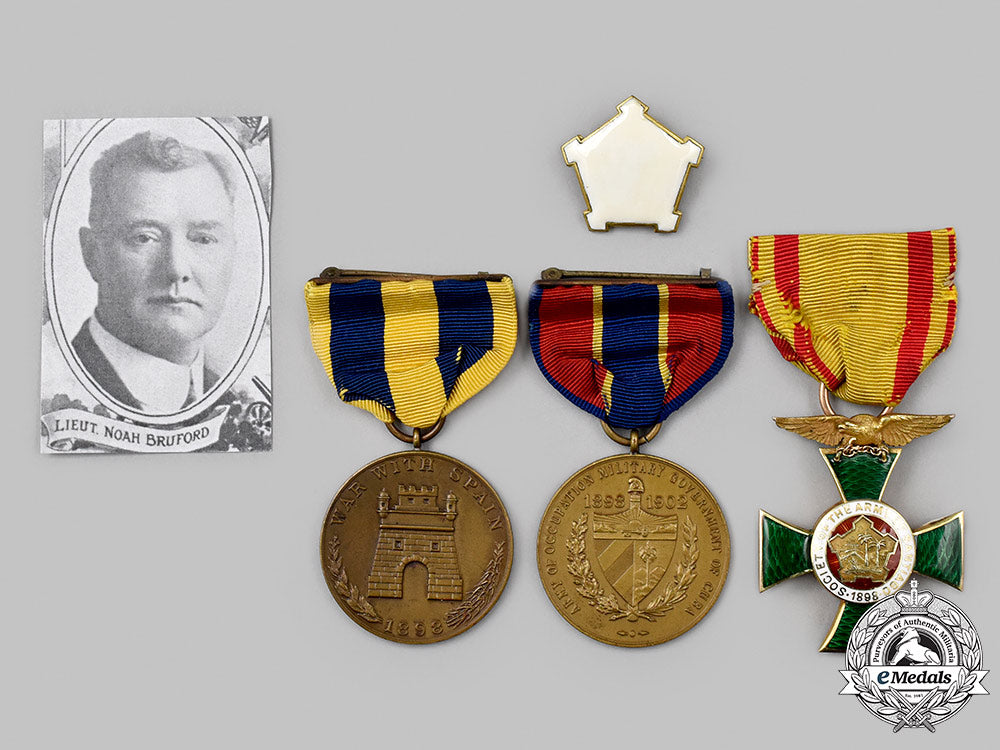
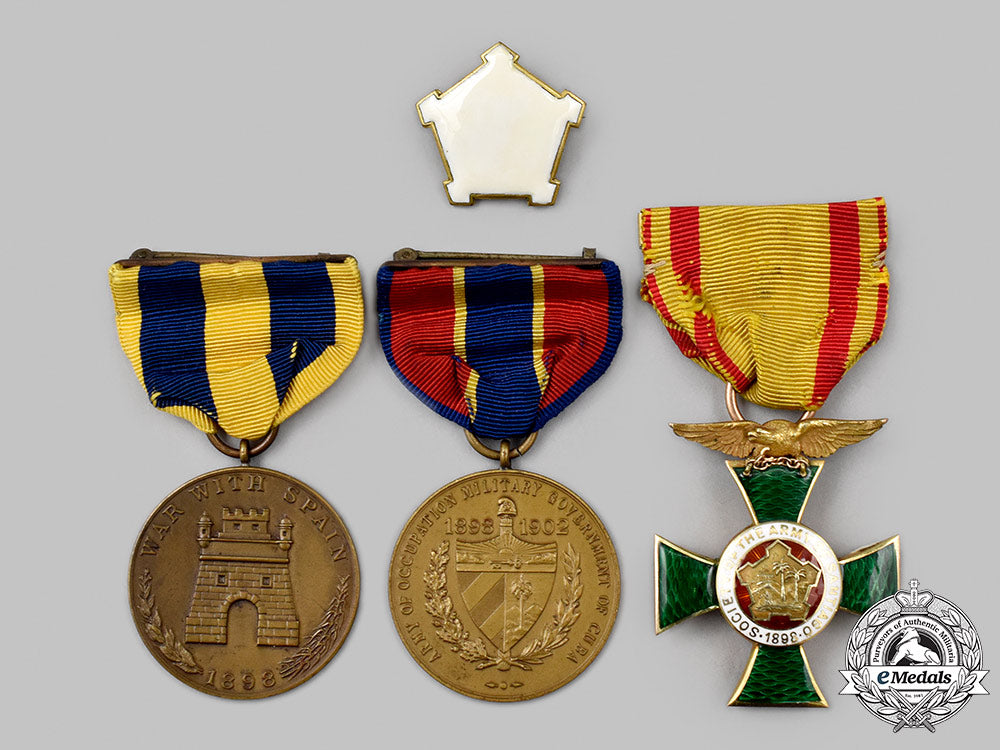
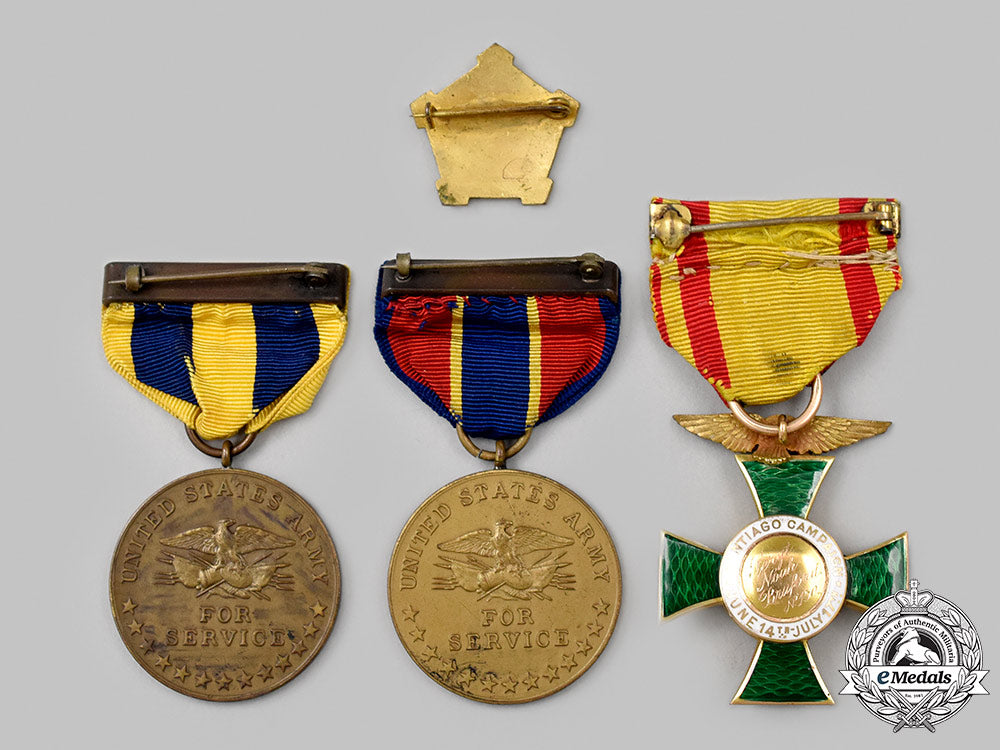
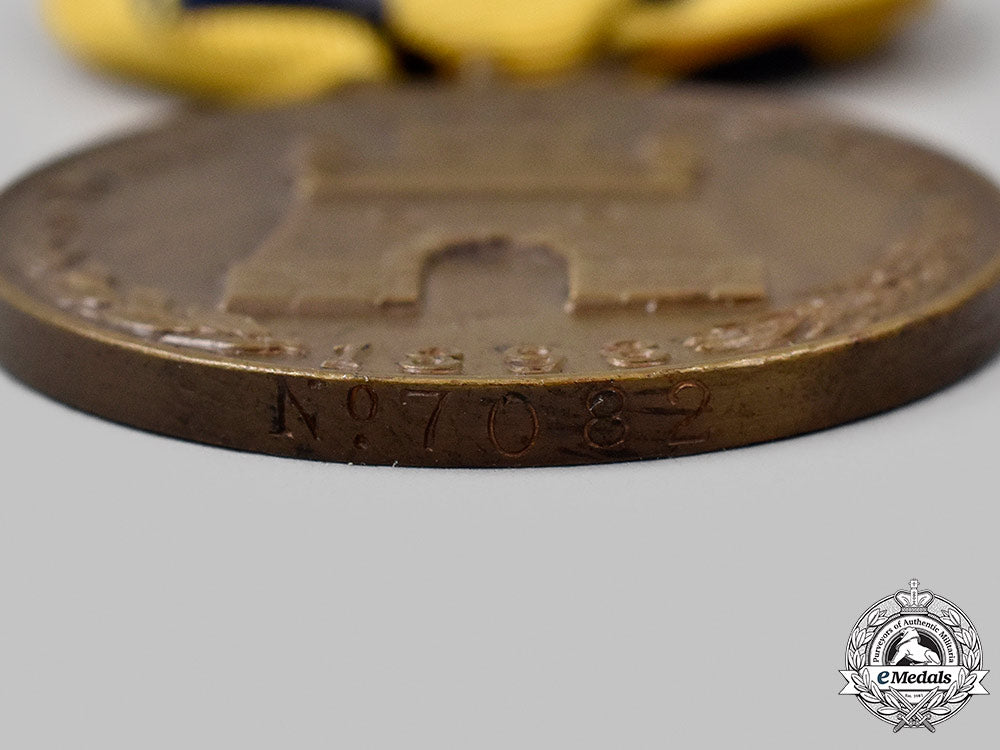
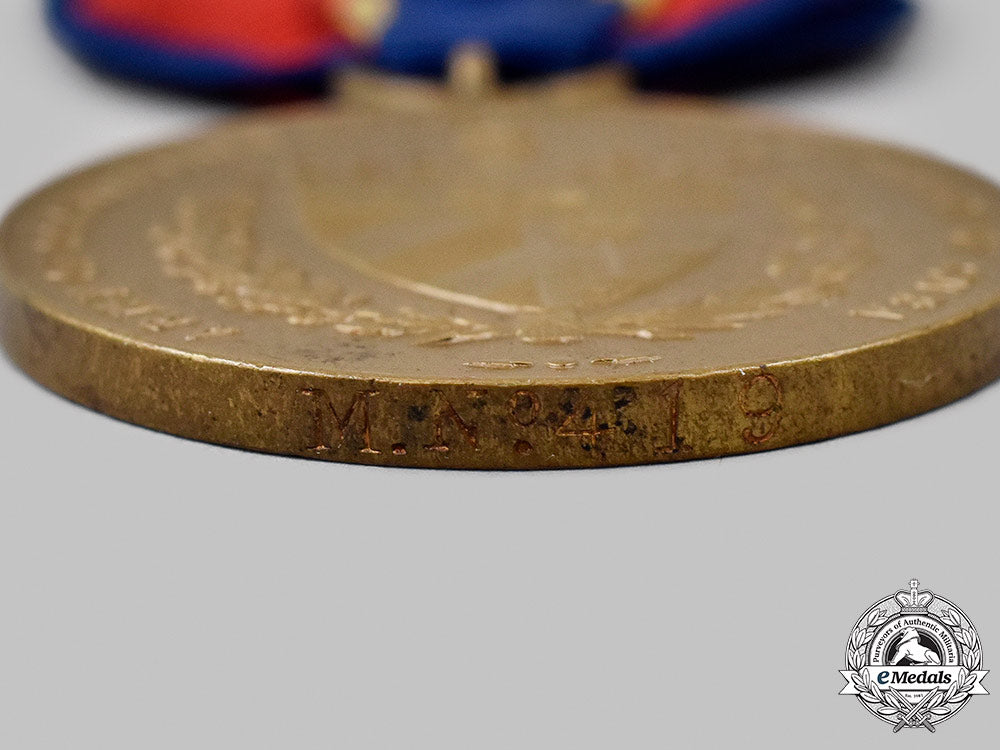
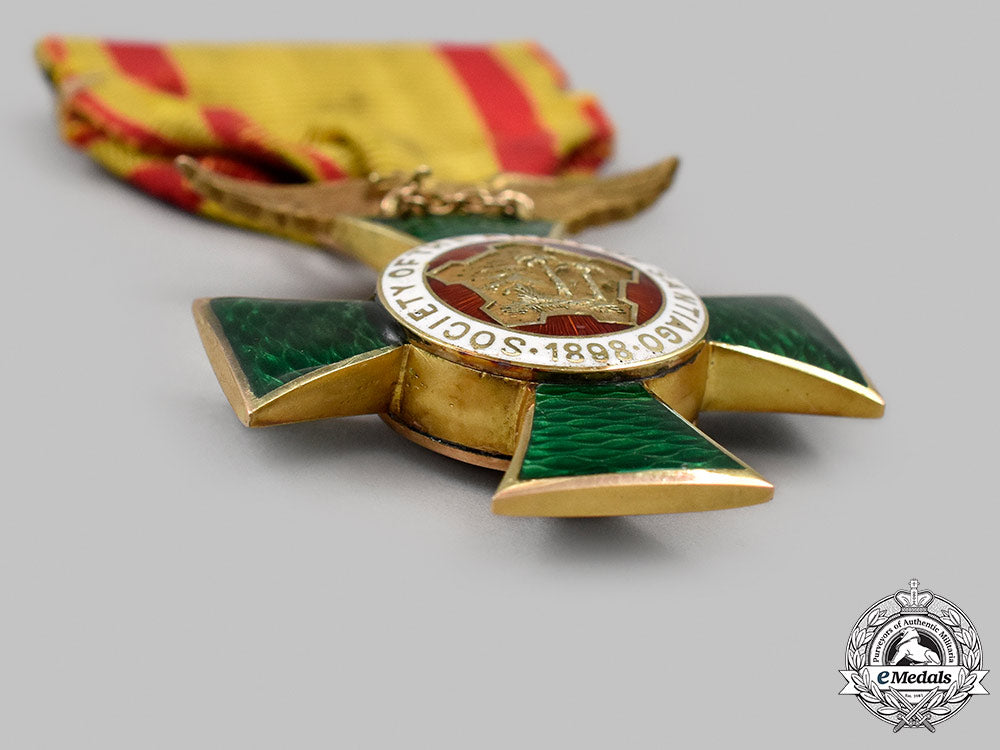
United States. A Spanish-American War Group, To Sergeant Bruford, C Company, 71St Regiment, New York Infantry
United States. A Spanish-American War Group, To Sergeant Bruford, C Company, 71St Regiment, New York Infantry
SKU: ITEM: W7246
0% Buyer's Premium
Current Bid:
Your Max Bid:
Bid History:
Time Remaining:
Couldn't load pickup availability
Shipping Details
Shipping Details
eMedals offers rapid domestic and international shipping. Orders received prior to 12:00pm (EST) will be shipped on the same business day.* Orders placed on Canadian Federal holidays will be dispatched the subsequent business day. Courier tracking numbers are provided for all shipments. All items purchased from eMedals can be returned for a full monetary refund or merchandise credit, providing the criteria presented in our Terms & Conditions are met. *Please note that the addition of a COA may impact dispatch time.
Shipping Details
eMedals offers rapid domestic and international shipping. Orders received prior to 12:00pm (EST) will be shipped on the same business day.* Orders placed on Canadian Federal holidays will be dispatched the subsequent business day. Courier tracking numbers are provided for all shipments. All items purchased from eMedals can be returned for a full monetary refund or merchandise credit, providing the criteria presented in our Terms & Conditions are met. *Please note that the addition of a COA may impact dispatch time.
Description
Description
Includes:
1. Army Spanish Campaign Medal 1898 (in bronze gilt, numbered "No. 7082" on the edge, measuring 33 mm in diameter, original second style ribbon with brooch pinback, spotting, contact marks).
2. Army of Cuban Occupation Medal 1898-1902 (in bronze gilt, numbered "M.No. 419" on the edge, measuring 33 mm in diameter, original ribbon with brooch pinback, spotting, contact marks).
3. Society of the Army of Santiago de Cuba Membership Cross 1898 (five-piece construction, in 14K Gold with red, white and green enamels, weighing 24.4 grams inclusive of its ribbon and pinback, marked "PAT. 7-4-99" on the ring, name engraved "Sergt. Noah Bruford. No. 150." in running script on the reverse centrepiece, measuring 34.5 mm (w) x 40.5 mm (h), original ribbon with brooch pinback, intact enamels).
4. Spanish-American War United States Army 5th Corps, 2nd Division Badge (in bronze gilt with white enamels, measuring 24.3 mm (w) x 23.2 mm (h), horizontal pinback, intact enamels).
Accompanied by copies of his Service Records, along with other pertinent personal paperwork and historical notes. Extremely fine.
Footnote:
1. The Society of the Army of Santiago de Cuba was established with membership open to U.S. Army and Volunteer officers and enlisted men who served in the Battle of Santiago, Cuba during the Spanish American War. Their stated purpose was to record and honor the history and memory of the campaign that began on June 14, 1898, which resulted in the surrender on July 17, 1898 of the Spanish Army at the City of Santiago de Cuba. Membership was open to those who served, their direct lineal descendant, and membership by inheritance as a descendant of a soldier killed in the battle. There was an honorary membership as well. Notable Society members include Major Generals Sumner and Chaffe, and Colonel Theodore Roosevelt.
2. Biography: Noah Bruford was born on May 10, 1860 in Liverpool, England, the son of John Bruford and Ann Bruford (nee Jones). He married his first wife, Annie E. Chambers Bruford, on May 3, 1883, the couple later having two children, a daughter, Grace Bruford (later Turney) and a son, Noah Bruford Jr. He later stated that his wife had been a drunk and that they had separated, with her leaving him in 1891. Bruford was a resident of New York City and was employed by the United States Post Office as a Letter Carrier, with seventeen years' service in the New York National Guard, when he enlisted for two years' service with C Company, 71st Regiment, New York Infantry, on May 2, 1898 in New York City, at the age of 37, for service in the Spanish-American War.
He was subsequently posted to Camp Black (1898-1898), a Spanish-American War Muster Camp established in 1898 on Hempstead Plains, near Garden City, Nassau County, Long Island, New York, the camp named after New York Governor Frank S. Black (1897-1898). He was mustered in as a Sergeant on May 10th, his 38th birthday, and was promoted to Color Sergeant on June 22, 1898. Color Sergeant Noah Bruford, C Company, 71st Regiment, New York Infantry traveled by ship and landed in Cuba on June 23, 1898.
He was with the 71st New York Volunteer Infantry Regiment, as part of the 1st Division, V Corps force that fought at the Battle of San Juan Hill, also known as the Battle for the San Juan Heights, a major battle of the Spanish-American War fought on July 2, 1898 between an American force under the command of William Rufus Shafter and Joseph Wheeler against a Spanish force led by Arsenio Linares y Pombo. The battle proved to be one of the most significant battles of the war and, along with the Siege of Santiago, a decisive battle in deciding the fate of the United States Army campaign in Cuba. The American forces, outnumbering the Spanish defenders sixteen-to-one, charged upon the heights and dispersed the Spanish after suffering heavy casualties.
Color Sergeant Bruford, 71st New York Volunteer Infantry Regiment was also at the Siege of Santiago (AKA the Siege of Santiago de Cuba), the last major operation of the Spanish-American War on the island of Cuba, which took place between July 3 and 17, 1898. The primary objective of the American Fifth Army Corps' invasion of Cuba was the capture of the city of Santiago de Cuba. U.S. forces had driven back the Spaniards' first line of defense at the Battle of Las Guasimas, after which General Arsenio Linares pulled his troops back to the main line of defense against Santiago along San Juan Heights. In the charge at the Battle of San Juan Hill, U.S. forces captured the Spanish position. At the Battle of El Caney the same day, U.S. forces took the fortified Spanish position and were then able to extend the U.S. flank on San Juan Hill. The destruction of the Spanish fleet at the Battle of Santiago de Cuba allowed U.S. forces to safely besiege the city.
Two and half weeks after the battle, upon the ceasing of hostilities, Bruford was hospitalized from July 18 to 28, 1898 with a case of "Famine Fever" (AKA epidemic typhus, AKA louse-borne typhus: a form of typhus so named because the disease often causes epidemics following wars and natural disasters where civil life is disrupted. Epidemic typhus is spread to people through contact with infected body lice, in contrast to endemic typhus which is usually transmitted by fleas). After ten days in hospital, he returned to duty.
He was hospitalized for a second time, from July 30th to August 7th with "Yellow Fever" (the disease caused by the yellow fever virus and is spread by the bite of an infected mosquito. It is typically of short duration and in most cases, symptoms include fever, chills, loss of appetite, nausea, muscle pains [particularly in the back] and headaches, with symptoms typically improving within five days in most cases), again returning to duty after a week. He was subsequently treated for "Malaria" on August 22nd (a mosquito-borne infectious disease that affects humans and other animals, causing symptoms that typically include fever, tiredness, vomiting, and headaches. In severe cases, it can cause yellow skin, seizures, coma, or death. Symptoms usually begin ten to fifteen days after being bitten by an infected mosquito and if not properly treated, people may have recurrences of the disease months later), Bruford returning to duty the same day.
Bruford remained with his regiment until ordered home in August 1898 and is acknowledged as having been on furlough from August 29th to October 27th. He was mustered out with the company and was honorably discharged on November 15, 1898 at New York City. He later achieved the rank of Brevet Second Lieutenant with the New York National Guard, and was in this rank when he applied for the Army Spanish Campaign Medal in October 1913. His service was reviewed and it was noted that his service in the conflict warranted issuing him the medal, number 7082, at a cost of forty-five cents ($ .45) from the United States Mint. His final rank was Lieutenant in the New York National Guard.
Bruford was 57 years old when he married Mona May Bruford (age 46) on March 31, 1917 in Englewood, New Jersey, the couple later settling in Newark, New Jersey. He received an annuity in the amount of $1200, as a former Federal Civil Servant with the Post Office Department (#15888), in addition to a pension from the government as having been a Spanish-American War veteran. He and his wife were part of a group of forty to fifty members of the United Spanish-American War Veterans and their families who sailed aboard the Clyde-Mallory liner S.S. Seminole, having just attended the organization's National Convention in Portland, Oregon in 1938, returning via Los Angeles, the Grand Canyon and Galveston, Texas.
Bruford was a Worshipful Brother in good standing with the Ancient Free and Accepted Masons Lodge No. 724 when he died from chronic cardiac valvular disease and general arteriosclerosis, along with chronic nephritis, on April 20, 1950, in Newark, New Jersey, at the age of 89. Masonic services were held on April 23rd at the Cole Funeral Home in Newark, followed by his burial on April 24th in Greenwood Cemetery in Brooklyn, New York, with a United States flag for burial purposes having been approved.
His first marriage had not been dissolved by either death or divorce at the time he married Mona May Bruford. He had previously stated to others, including his second wife, Mona, that he was a widower, although his two children from that first marriage knew that their mother was alive and had re-married. His first wife, Annie E. Chambers Bruford (later marrying and becoming Annie E. Rebel), died on May 8, 1932 in Richmond Hill, Long Island, New York. In order to receive her husband's death benefit, Mona had to prove that she was his dependent and that any continuance of his pension should go to her, and not his first wife, Annie.
In a sworn deposition by his widow, Mona May Bruford, she noted that two days before his death, "on or about April 18, 1950 my husband asked me to send for Otto Wittich Esq., 29 Maud St., Newark, N.J., the Service Officer of the United Spanish War Veterans, Franklin Camp #29, at Newark, New Jersey, and Mr. Wittich arrived that day. My husband, unable to leave his bed during his last illness, talked for some time to Mr. Wittich, not knowing that I was also present in the room and (my husband) told him that he had a confession to make: That his first wife Annie E. Chambers Bruford had been a drunk and had left his home and board about 1891. That he had not heard from her in many years and presumed her dead when he remarried to me, Mona May, and that thereafter upon learning of her still living was afraid to inform me, as we were living as man and wife and had so lived since our marriage."
Mona Maud Bruford filed for his death benefit from the Dependents & Beneficiaries Claims Service, Veterans Administration and with the help of Otto Wittich, the Service Officer of the United Spanish War Veterans, Franklin Camp #29, along with legal assistance, was able to prove her claim and receive the death benefit. However, in the correspondences, there are claims by some that this was a common law arrangement and not a marriage. In fact, they were married, as evidenced by the State of New Jersey Bureau of Vital Statistics Certificate and Record of Marriage that was issued. She died on December 31, 1963 in New Hartford, New York and is buried in Westernville Cemetery, in Westernville, Oneida County, New York.
Description
Includes:
1. Army Spanish Campaign Medal 1898 (in bronze gilt, numbered "No. 7082" on the edge, measuring 33 mm in diameter, original second style ribbon with brooch pinback, spotting, contact marks).
2. Army of Cuban Occupation Medal 1898-1902 (in bronze gilt, numbered "M.No. 419" on the edge, measuring 33 mm in diameter, original ribbon with brooch pinback, spotting, contact marks).
3. Society of the Army of Santiago de Cuba Membership Cross 1898 (five-piece construction, in 14K Gold with red, white and green enamels, weighing 24.4 grams inclusive of its ribbon and pinback, marked "PAT. 7-4-99" on the ring, name engraved "Sergt. Noah Bruford. No. 150." in running script on the reverse centrepiece, measuring 34.5 mm (w) x 40.5 mm (h), original ribbon with brooch pinback, intact enamels).
4. Spanish-American War United States Army 5th Corps, 2nd Division Badge (in bronze gilt with white enamels, measuring 24.3 mm (w) x 23.2 mm (h), horizontal pinback, intact enamels).
Accompanied by copies of his Service Records, along with other pertinent personal paperwork and historical notes. Extremely fine.
Footnote:
1. The Society of the Army of Santiago de Cuba was established with membership open to U.S. Army and Volunteer officers and enlisted men who served in the Battle of Santiago, Cuba during the Spanish American War. Their stated purpose was to record and honor the history and memory of the campaign that began on June 14, 1898, which resulted in the surrender on July 17, 1898 of the Spanish Army at the City of Santiago de Cuba. Membership was open to those who served, their direct lineal descendant, and membership by inheritance as a descendant of a soldier killed in the battle. There was an honorary membership as well. Notable Society members include Major Generals Sumner and Chaffe, and Colonel Theodore Roosevelt.
2. Biography: Noah Bruford was born on May 10, 1860 in Liverpool, England, the son of John Bruford and Ann Bruford (nee Jones). He married his first wife, Annie E. Chambers Bruford, on May 3, 1883, the couple later having two children, a daughter, Grace Bruford (later Turney) and a son, Noah Bruford Jr. He later stated that his wife had been a drunk and that they had separated, with her leaving him in 1891. Bruford was a resident of New York City and was employed by the United States Post Office as a Letter Carrier, with seventeen years' service in the New York National Guard, when he enlisted for two years' service with C Company, 71st Regiment, New York Infantry, on May 2, 1898 in New York City, at the age of 37, for service in the Spanish-American War.
He was subsequently posted to Camp Black (1898-1898), a Spanish-American War Muster Camp established in 1898 on Hempstead Plains, near Garden City, Nassau County, Long Island, New York, the camp named after New York Governor Frank S. Black (1897-1898). He was mustered in as a Sergeant on May 10th, his 38th birthday, and was promoted to Color Sergeant on June 22, 1898. Color Sergeant Noah Bruford, C Company, 71st Regiment, New York Infantry traveled by ship and landed in Cuba on June 23, 1898.
He was with the 71st New York Volunteer Infantry Regiment, as part of the 1st Division, V Corps force that fought at the Battle of San Juan Hill, also known as the Battle for the San Juan Heights, a major battle of the Spanish-American War fought on July 2, 1898 between an American force under the command of William Rufus Shafter and Joseph Wheeler against a Spanish force led by Arsenio Linares y Pombo. The battle proved to be one of the most significant battles of the war and, along with the Siege of Santiago, a decisive battle in deciding the fate of the United States Army campaign in Cuba. The American forces, outnumbering the Spanish defenders sixteen-to-one, charged upon the heights and dispersed the Spanish after suffering heavy casualties.
Color Sergeant Bruford, 71st New York Volunteer Infantry Regiment was also at the Siege of Santiago (AKA the Siege of Santiago de Cuba), the last major operation of the Spanish-American War on the island of Cuba, which took place between July 3 and 17, 1898. The primary objective of the American Fifth Army Corps' invasion of Cuba was the capture of the city of Santiago de Cuba. U.S. forces had driven back the Spaniards' first line of defense at the Battle of Las Guasimas, after which General Arsenio Linares pulled his troops back to the main line of defense against Santiago along San Juan Heights. In the charge at the Battle of San Juan Hill, U.S. forces captured the Spanish position. At the Battle of El Caney the same day, U.S. forces took the fortified Spanish position and were then able to extend the U.S. flank on San Juan Hill. The destruction of the Spanish fleet at the Battle of Santiago de Cuba allowed U.S. forces to safely besiege the city.
Two and half weeks after the battle, upon the ceasing of hostilities, Bruford was hospitalized from July 18 to 28, 1898 with a case of "Famine Fever" (AKA epidemic typhus, AKA louse-borne typhus: a form of typhus so named because the disease often causes epidemics following wars and natural disasters where civil life is disrupted. Epidemic typhus is spread to people through contact with infected body lice, in contrast to endemic typhus which is usually transmitted by fleas). After ten days in hospital, he returned to duty.
He was hospitalized for a second time, from July 30th to August 7th with "Yellow Fever" (the disease caused by the yellow fever virus and is spread by the bite of an infected mosquito. It is typically of short duration and in most cases, symptoms include fever, chills, loss of appetite, nausea, muscle pains [particularly in the back] and headaches, with symptoms typically improving within five days in most cases), again returning to duty after a week. He was subsequently treated for "Malaria" on August 22nd (a mosquito-borne infectious disease that affects humans and other animals, causing symptoms that typically include fever, tiredness, vomiting, and headaches. In severe cases, it can cause yellow skin, seizures, coma, or death. Symptoms usually begin ten to fifteen days after being bitten by an infected mosquito and if not properly treated, people may have recurrences of the disease months later), Bruford returning to duty the same day.
Bruford remained with his regiment until ordered home in August 1898 and is acknowledged as having been on furlough from August 29th to October 27th. He was mustered out with the company and was honorably discharged on November 15, 1898 at New York City. He later achieved the rank of Brevet Second Lieutenant with the New York National Guard, and was in this rank when he applied for the Army Spanish Campaign Medal in October 1913. His service was reviewed and it was noted that his service in the conflict warranted issuing him the medal, number 7082, at a cost of forty-five cents ($ .45) from the United States Mint. His final rank was Lieutenant in the New York National Guard.
Bruford was 57 years old when he married Mona May Bruford (age 46) on March 31, 1917 in Englewood, New Jersey, the couple later settling in Newark, New Jersey. He received an annuity in the amount of $1200, as a former Federal Civil Servant with the Post Office Department (#15888), in addition to a pension from the government as having been a Spanish-American War veteran. He and his wife were part of a group of forty to fifty members of the United Spanish-American War Veterans and their families who sailed aboard the Clyde-Mallory liner S.S. Seminole, having just attended the organization's National Convention in Portland, Oregon in 1938, returning via Los Angeles, the Grand Canyon and Galveston, Texas.
Bruford was a Worshipful Brother in good standing with the Ancient Free and Accepted Masons Lodge No. 724 when he died from chronic cardiac valvular disease and general arteriosclerosis, along with chronic nephritis, on April 20, 1950, in Newark, New Jersey, at the age of 89. Masonic services were held on April 23rd at the Cole Funeral Home in Newark, followed by his burial on April 24th in Greenwood Cemetery in Brooklyn, New York, with a United States flag for burial purposes having been approved.
His first marriage had not been dissolved by either death or divorce at the time he married Mona May Bruford. He had previously stated to others, including his second wife, Mona, that he was a widower, although his two children from that first marriage knew that their mother was alive and had re-married. His first wife, Annie E. Chambers Bruford (later marrying and becoming Annie E. Rebel), died on May 8, 1932 in Richmond Hill, Long Island, New York. In order to receive her husband's death benefit, Mona had to prove that she was his dependent and that any continuance of his pension should go to her, and not his first wife, Annie.
In a sworn deposition by his widow, Mona May Bruford, she noted that two days before his death, "on or about April 18, 1950 my husband asked me to send for Otto Wittich Esq., 29 Maud St., Newark, N.J., the Service Officer of the United Spanish War Veterans, Franklin Camp #29, at Newark, New Jersey, and Mr. Wittich arrived that day. My husband, unable to leave his bed during his last illness, talked for some time to Mr. Wittich, not knowing that I was also present in the room and (my husband) told him that he had a confession to make: That his first wife Annie E. Chambers Bruford had been a drunk and had left his home and board about 1891. That he had not heard from her in many years and presumed her dead when he remarried to me, Mona May, and that thereafter upon learning of her still living was afraid to inform me, as we were living as man and wife and had so lived since our marriage."
Mona Maud Bruford filed for his death benefit from the Dependents & Beneficiaries Claims Service, Veterans Administration and with the help of Otto Wittich, the Service Officer of the United Spanish War Veterans, Franklin Camp #29, along with legal assistance, was able to prove her claim and receive the death benefit. However, in the correspondences, there are claims by some that this was a common law arrangement and not a marriage. In fact, they were married, as evidenced by the State of New Jersey Bureau of Vital Statistics Certificate and Record of Marriage that was issued. She died on December 31, 1963 in New Hartford, New York and is buried in Westernville Cemetery, in Westernville, Oneida County, New York.






You May Also Like
Germany, Third Reich. A Mixed Lot of Tyrolean Marksmanship Badges
G52930
Germany, SS. An Estonian Waffen-SS Volunteer’s Sleeve Shield
G50381
Germany, SS. A Waffen-SS Sturmmann Sleeve Insignia
G52846
Germany, Third Reich; Slovakia, First Republic. A Mixed Lot of Wartime Postcards
G52905
Germany, Third Reich. A Pair of Tyrolean Marksmanship Badges
G52981
-
Germany, Third Reich. A Mixed Lot of Tyrolean Marksmanship Badges
G52930
Add to CartRegular price $135 USDRegular price $0 USD Sale price $135 USDUnit price / per -
Germany, SS. An Estonian Waffen-SS Volunteer’s Sleeve Shield
G50381
Add to CartRegular price $150 USDRegular price $0 USD Sale price $150 USDUnit price / per -
Germany, SS. A Waffen-SS Sturmmann Sleeve Insignia
G52846
Add to CartRegular price $135 USDRegular price $0 USD Sale price $135 USDUnit price / per -
Germany, Third Reich; Slovakia, First Republic. A Mixed Lot of Wartime Postcards
G52905
Add to CartRegular price $135 USDRegular price $0 USD Sale price $135 USDUnit price / per -
Germany, Third Reich. A Pair of Tyrolean Marksmanship Badges
G52981
Add to CartRegular price $135 USDRegular price $0 USD Sale price $135 USDUnit price / per
Do you have a similar item you are interested in selling?
Please complete the form and our client care representatives will contact you.
Sell Item
















